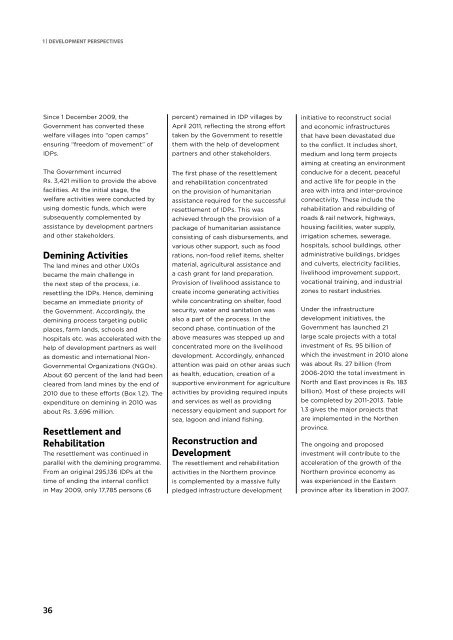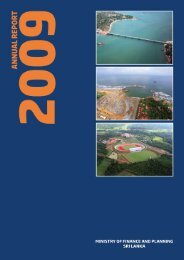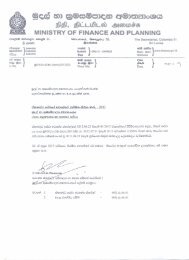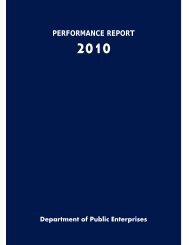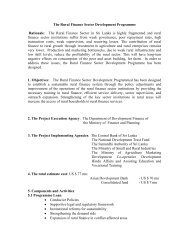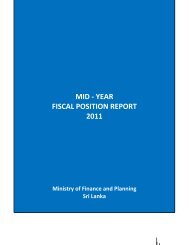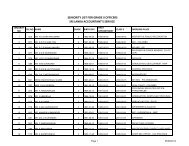Annual Report 2010 - Ministry of Finance and Planning
Annual Report 2010 - Ministry of Finance and Planning
Annual Report 2010 - Ministry of Finance and Planning
You also want an ePaper? Increase the reach of your titles
YUMPU automatically turns print PDFs into web optimized ePapers that Google loves.
1 | DEVELOPMENT PERSPECTIVESSince 1 December 2009, theGovernment has converted thesewelfare villages into “open camps”ensuring “freedom <strong>of</strong> movement” <strong>of</strong>IDPs.The Government incurredRs. 3,421 million to provide the abovefacilities. At the initial stage, thewelfare activities were conducted byusing domestic funds, which weresubsequently complemented byassistance by development partners<strong>and</strong> other stakeholders.Demining ActivitiesThe l<strong>and</strong> mines <strong>and</strong> other UXOsbecame the main challenge inthe next step <strong>of</strong> the process, i.e.resettling the IDPs. Hence, deminingbecame an immediate priority <strong>of</strong>the Government. Accordingly, thedemining process targeting publicplaces, farm l<strong>and</strong>s, schools <strong>and</strong>hospitals etc. was accelerated with thehelp <strong>of</strong> development partners as wellas domestic <strong>and</strong> international Non-Governmental Organizations (NGOs).About 60 percent <strong>of</strong> the l<strong>and</strong> had beencleared from l<strong>and</strong> mines by the end <strong>of</strong><strong>2010</strong> due to these efforts (Box 1.2). Theexpenditure on demining in <strong>2010</strong> wasabout Rs. 3,696 million.Resettlement <strong>and</strong>RehabilitationThe resettlement was continued inparallel with the demining programme.From an original 295,136 IDPs at thetime <strong>of</strong> ending the internal conflictin May 2009, only 17,785 persons (6percent) remained in IDP villages byApril 2011, reflecting the strong efforttaken by the Government to resettlethem with the help <strong>of</strong> developmentpartners <strong>and</strong> other stakeholders.The first phase <strong>of</strong> the resettlement<strong>and</strong> rehabilitation concentratedon the provision <strong>of</strong> humanitarianassistance required for the successfulresettlement <strong>of</strong> IDPs. This wasachieved through the provision <strong>of</strong> apackage <strong>of</strong> humanitarian assistanceconsisting <strong>of</strong> cash disbursements, <strong>and</strong>various other support, such as foodrations, non-food relief items, sheltermaterial, agricultural assistance <strong>and</strong>a cash grant for l<strong>and</strong> preparation.Provision <strong>of</strong> livelihood assistance tocreate income generating activitieswhile concentrating on shelter, foodsecurity, water <strong>and</strong> sanitation wasalso a part <strong>of</strong> the process. In thesecond phase, continuation <strong>of</strong> theabove measures was stepped up <strong>and</strong>concentrated more on the livelihooddevelopment. Accordingly, enhancedattention was paid on other areas suchas health, education, creation <strong>of</strong> asupportive environment for agricultureactivities by providing required inputs<strong>and</strong> services as well as providingnecessary equipment <strong>and</strong> support forsea, lagoon <strong>and</strong> inl<strong>and</strong> fishing.Reconstruction <strong>and</strong>DevelopmentThe resettlement <strong>and</strong> rehabilitationactivities in the Northern provinceis complemented by a massive fullypledged infrastructure developmentinitiative to reconstruct social<strong>and</strong> economic infrastructuresthat have been devastated dueto the conflict. It includes short,medium <strong>and</strong> long term projectsaiming at creating an environmentconducive for a decent, peaceful<strong>and</strong> active life for people in thearea with intra <strong>and</strong> inter-provinceconnectivity. These include therehabilitation <strong>and</strong> rebuilding <strong>of</strong>roads & rail network, highways,housing facilities, water supply,irrigation schemes, sewerage,hospitals, school buildings, otheradministrative buildings, bridges<strong>and</strong> culverts, electricity facilities,livelihood improvement support,vocational training, <strong>and</strong> industrialzones to restart industries.Under the infrastructuredevelopment initiatives, theGovernment has launched 21large scale projects with a totalinvestment <strong>of</strong> Rs. 95 billion <strong>of</strong>which the investment in <strong>2010</strong> alonewas about Rs. 27 billion (from2006-<strong>2010</strong> the total investment inNorth <strong>and</strong> East provinces is Rs. 183billion). Most <strong>of</strong> these projects willbe completed by 2011-2013. Table1.3 gives the major projects thatare implemented in the Northenprovince.The ongoing <strong>and</strong> proposedinvestment will contribute to theacceleration <strong>of</strong> the growth <strong>of</strong> theNorthern province economy aswas experienced in the Easternprovince after its liberation in 2007.36


